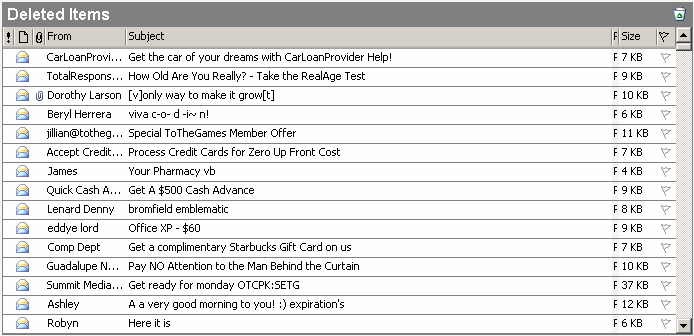Internet Technologies/Email spam
Email spam (or just "Spam") is unsolicited email, similar to conventional "junk mail", but often on a larger scale.
Spam is estimated to have cost U.S. organizations over $10 billion (in lost productivity) in 2003.
Various software products are available to block or filter spam. Even lawmakers are stepping up to fight spam- in the United States the Can-Spam Act of 2003 was passed into law.
"Spammers" - people or organizations responsible for sending out email spam - use large lists of email addresses that are collected in a number of ways. One of these means is by using computer programs that search websites for email addresses. An email address that appears on a website is therefore more likely to get spammed, other things being equal. There are various ways of preventing your email being harvested in this way. One is to include it as an image rather than a link. This is not ideal, though, because it means firstly that people will have to type the address themselves, and secondly, it makes the address inaccessible to blind people, or people who browse without images. An alternative, better method, is to use a small piece of 'JavaScript' to insert the email address into the page when it is displayed, keeping it out of the html which an email-collecting spam program might look at. One final method is to create a contact form to display on your website. The website user would fill out the form which when submitted forwards the message to you without displaying your email address. This final method has one drawback in that it circumvents the user's email system and does not provide the user with a record of the email that they sent.
I have also seen many people try the format of me@REMOVETHISaol.com or whatever. The person who has a genuine interest in emailing you will remove the REMOVETHIS part of the eddress before sending, but programmes that gather email addresses en-masse will use it as-is - thus, you do not receive spam. One must be fairly inventive to make this effective; the instance given would be algorithmically handled by most site-scraping email bots.
In addition, there is a new anti-spam feature now available. Named the "Challenge/Response System", this either sends a link, or a word-verification page to a user, the first time they e-mail you. The user must either click the link or enter the word to verify they are not a spamming program. After this, you get the e-mail and they're added to your allow list.
A study, by Brockmann & Company IT consultants showed that challenge-response proved to be superior to appliances, hosted spam filters and commercial filters.Brockmann surveyed more than 500 businesses, with 40% of the respondents having IT responsibilities. The independently funded study resulted in the creation of a spam index to measure how satisfied workers were with their spam technologies.
Despite being less sophisticated than filtering technology sold by antispam and antivirus vendors, the challenge-response method was twice as effective as hosted services for spam prevention. According to the survey, 67% of challenge-response users specified that they are very satisfied with their email experience as compared to next highest technology, hosted services, in which 42% reported that they were very satisfied. Commercial software filters, such as those produced by McAfee, Symantec and Trend Micro, scored the lowest satisfying only 22% of respondents.(SearchSecurity.com, Robert Westervelt Jul. 2007)
www.bluebottle.com currently offers a public beta of this software.
Spam is a very common thing and at one point or another it is something that we have all had. Spam is not only an annoying email, it is a tactics for marketing. However many times you have received this type of email, it is becoming more and more dangerous. It can be generated by businesses as well as individuals. It is used to promote products and is also brought about by things like forwarding ( things like jokes, images or chain letters) spam can be used to gather information from your computer if opened as well as used to send out viruses. It is becoming an increasing threat. Spam has become such an issue, that people now have to have an entire email address just as a "throw away account" an email address specifically catered toward junk mail because if we were to let it, it would take up about 90% of our inbox's, not only is this an issue for our email account but it is also being directed towards our phone, and needs to be handled with caution
Email-spam-sample.png
Spam is a very common thing and at one point or another it is something that we have all had. Spam is not only an annoying email, it is a tactics for marketing. However many times you have received this type of email, it is becoming more and more dangerous. It can be generated by businesses as well as individuals. It is used to promote products and is also brought about by things like forwarding ( things like jokes, images or chain letters) spam can be used to gather information from your computer if opened as well as used to send out viruses. It is becoming an increasing threat. Spam has become such an issue, that people now have to have an entire email address just as a "throw away account" an email address specifically catered toward junk mail because if we were to let it, it would take up about 90% of our inbox's, not only is this an issue for our email account but it is also being directed towards our phone, and needs to be handled with caution

External Links
edit- Can-Spam Act of 2003
- The Coalition Against Unsolicited Commercial Email
- Fight Spam on the Internet!
- Spam Assassin Website - Server software designed to detect Spam and denote it before the user downloads the message.